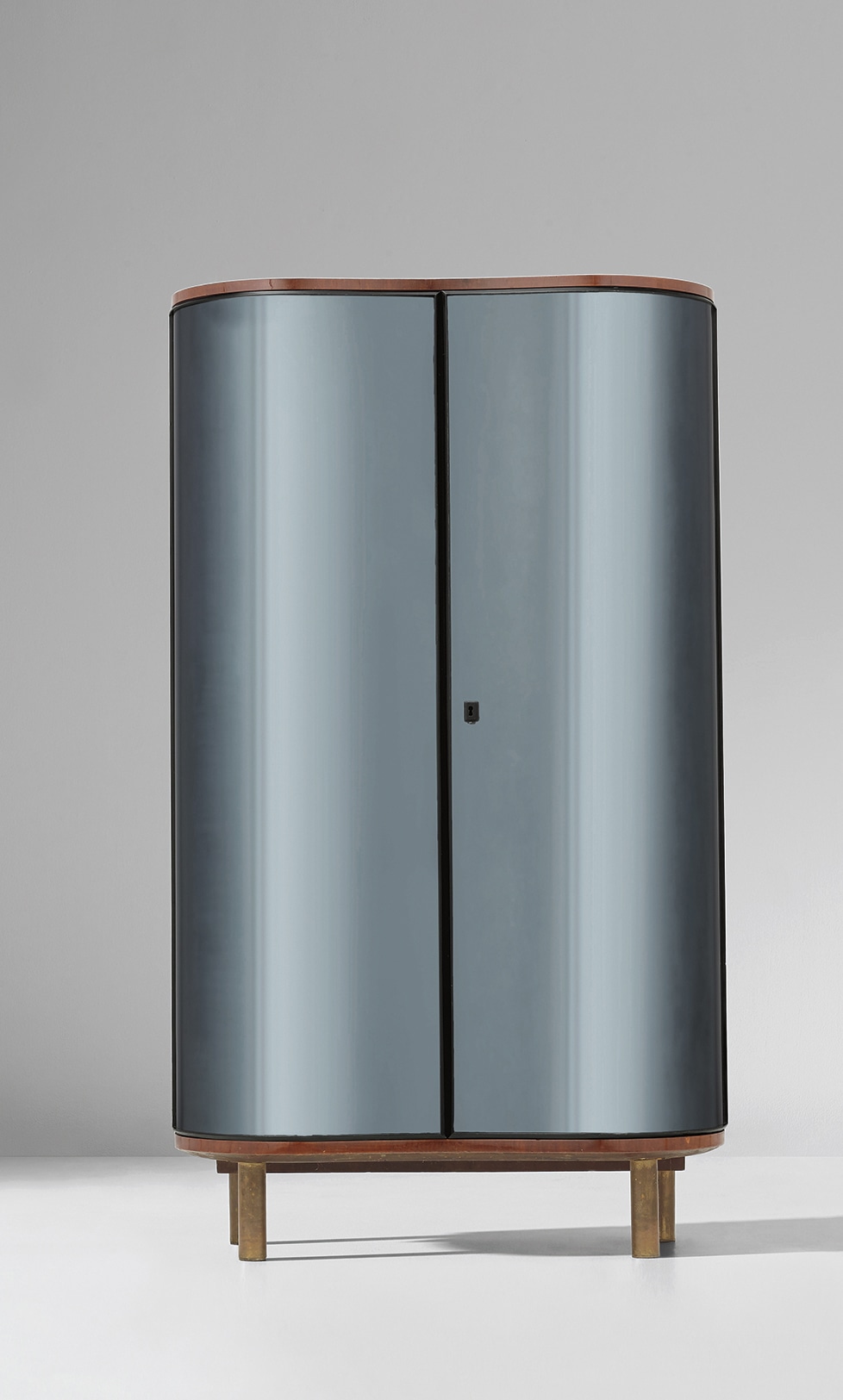
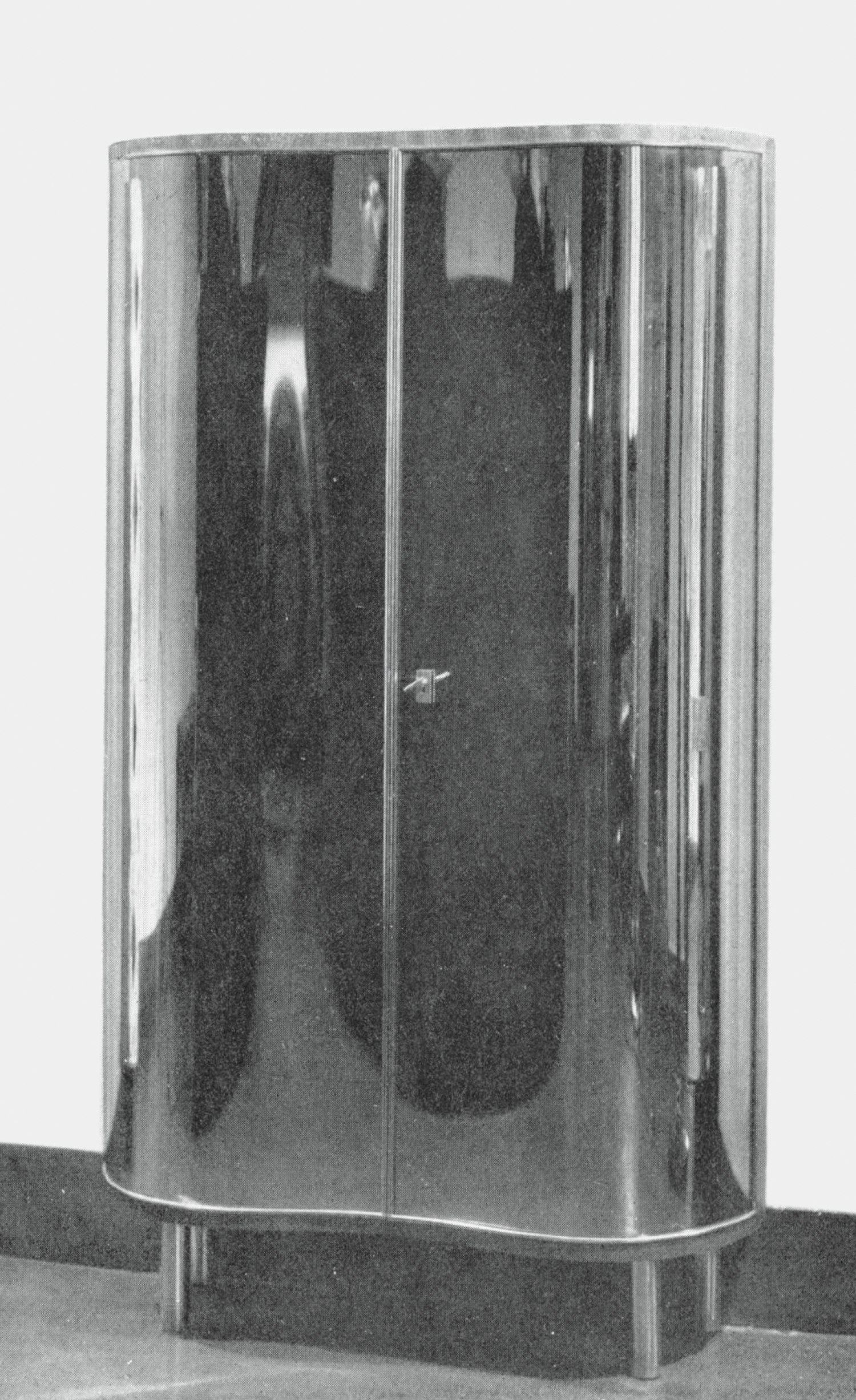
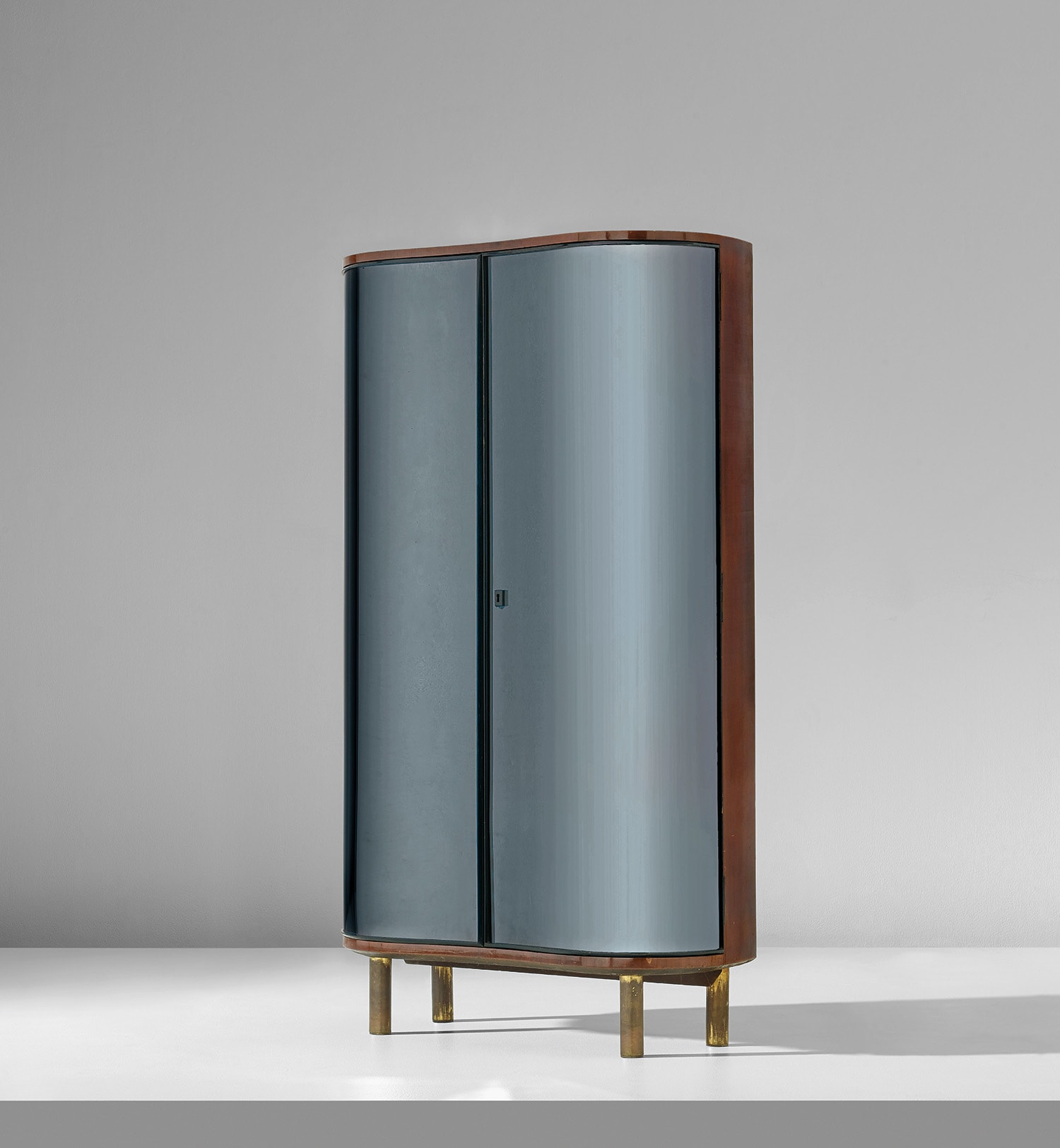
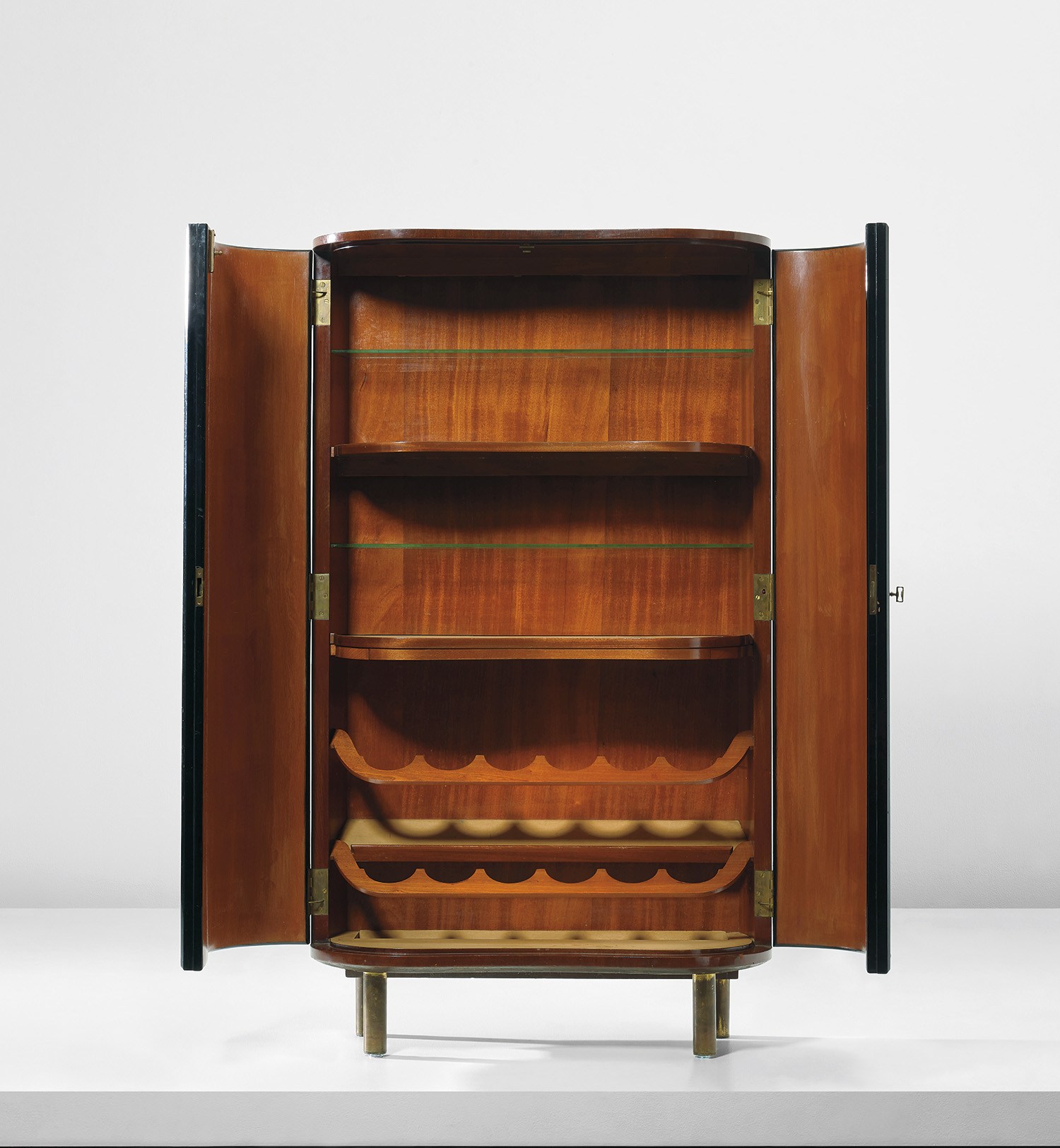
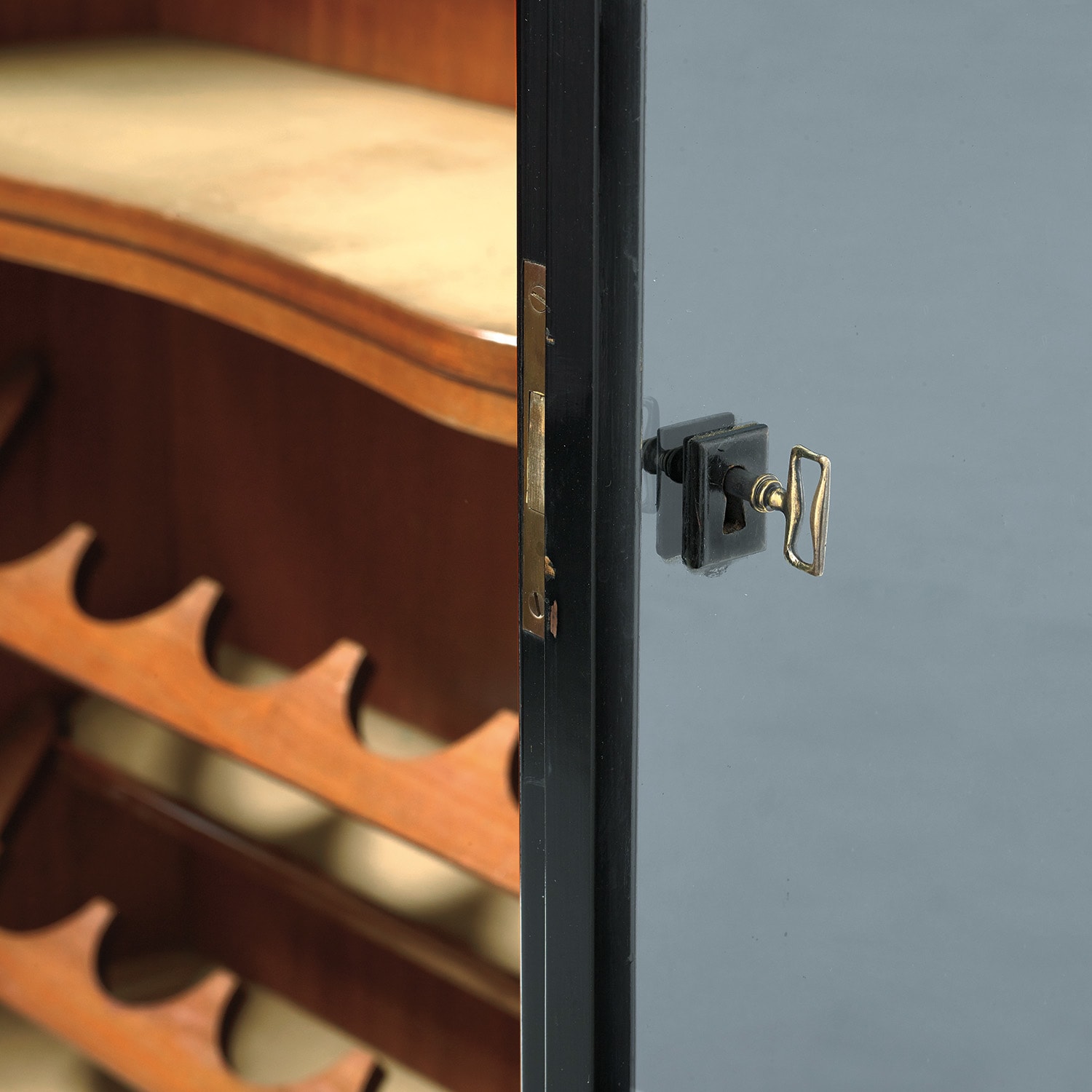





8
Pietro Chiesa
Important and rare illuminated drinks cabinet
circa 1939
Coloured mirrored glass, mahogany-veneered wood, mahogany, painted wood, laminated wood, glass, brass.
140 x 81 x 32.5 cm (55 1/8 x 31 7/8 x 12 3/4 in.)
Manufactured by Fontana Arte, Milan, Italy.
Full-Cataloguing
In March 1949, Gio Ponti dedicated an extensive article in Domus to the work of his friend Pietro Chiesa, following the Milanese designer’s death the previous year. The opening pages of the article featured a portrait of Chiesa (illustrated) looking out through one of his small carved glass sculptures, capturing his investigative spirit, and in which Ponti commented that the image, ‘…symbolises in a touching way the extreme relentless need for perfection and quality that was the central rule in his work within the field [of glass]’. Chiesa’s enduring interest in glass, both for its celebrated history throughout Italian design and its inherent material qualities, developed during the 1920s, having established his own studio in Milan creating stained-glass windows, and continued to inform and inspire his work at Fontana Arte. Appointed co-artistic director of the firm with Ponti in 1934, Chiesa designed masterfully-crafted lighting and furniture, greatly contributing to Fontana Arte’s preeminent artistic glass production. Describing a series of ‘Mobili Essenziali’, which comprised mirrored glass table and cabinet designs, including the present model, Ponti wrote in his 1949 article that, 'In these works Pietro Chiesa has achieved … that 'essentiality' in which the lines are ‘pulled' to their most absolute expression and do not require any additions or modifications'. (Gio Ponti, 'L'opera di Pietro Chiesa', Domus, no. 234, March 1949, pp. 34, 38)
Designed by Chiesa in the late 1930s, the present illuminated drinks cabinet elegantly combines a modernist and functionalist visual language, emphasising a ‘purity of line’ that equally embraces a curvilinear, organic form. The undulating shape of the cabinet’s curved glass doors extends from an otherwise purely rationalist structure comprising a mahogany-veneered wood frame and sturdy tubular brass feet. The chromatic quality of the extraordinary mirrored plate glass replaces earlier classical decoration, for example the intricate inlays and gilding found in traditional Italian cabinetry, which is subtly evoked by the outline of the cabinet’s form and preserved through its modern interpretation by Chiesa’s use of the sophisticated processing techniques required to produce both curved and mirrored glass. Experimenting with both the aesthetic and technical possibilities of the modern material, Chiesa embellished entire surfaces of his furnishings using glass, sometimes incorporating vibrant colours, exploiting the expressive potential of the medium. He also explored the thickness of cut glass, innovatively allowing for the material to play a weight bearing role in several large tables, as demonstrated by the designer’s rare table (lot 26).
The present cabinet illustrates a duality in Chiesa’s work, uniting artisan and semi-industrial production, whilst subverting the rationalism of the rectilinear frame through the introduction of curvilinear forms, underscoring Ponti’s identification of the ‘extreme essentialness’ of these designs. In the late 1930s, a vocabulary of organic Modernism had been adopted by several architects and designers, informed by the Surrealist movement, which had emerged in Paris during the 1920s and developed through the 1930s. In addition to providing formal inspiration, Surrealism's exploration of the emotional and the psychological, offered a means to examine the humanising of technology. The undulating cabinet doors of the present cabinet have a biomorphic quality, a visual language that developed from Surrealism. In the 1936 exhibition ‘Cubism and Abstract Art’, Surrealist art was described as, ‘organic or biomorphic rather than geometric in its forms; curvilinear rather than rectilinear, decorative rather than structural and romantic rather than classical in its exaltation of the mystical, the spontaneous and the irrational’ (Barr, Alfred H., Jr., Cubism and Abstract Art, exh. cat., The Museum of Modern Art, New York, 1936, p. 19) Underscoring this contextualisation, is the distortion of the viewer’s reflection in the curved glass of the cabinet doors, which appears to collapse the distinction between object, subject and the surrounding space. Reflecting his pursuit of modernity, the present drinks cabinet is ‘specifically organic and essential’, the words used by André Breton in his 1937 Surrealist text Mad Love in reference to Paris - described by Ponti in his article as Chiesa’s favourite city, where he often visited to collect rare books from the Romantic period (André Breton, Mad Love, Mary Ann Caws, trans., Lincoln, 1987, p. 47 and Gio Ponti, 'L'opera di Pietro Chiesa', Domus, no. 234, March 1949, p. 46).
Designed by Chiesa in the late 1930s, the present illuminated drinks cabinet elegantly combines a modernist and functionalist visual language, emphasising a ‘purity of line’ that equally embraces a curvilinear, organic form. The undulating shape of the cabinet’s curved glass doors extends from an otherwise purely rationalist structure comprising a mahogany-veneered wood frame and sturdy tubular brass feet. The chromatic quality of the extraordinary mirrored plate glass replaces earlier classical decoration, for example the intricate inlays and gilding found in traditional Italian cabinetry, which is subtly evoked by the outline of the cabinet’s form and preserved through its modern interpretation by Chiesa’s use of the sophisticated processing techniques required to produce both curved and mirrored glass. Experimenting with both the aesthetic and technical possibilities of the modern material, Chiesa embellished entire surfaces of his furnishings using glass, sometimes incorporating vibrant colours, exploiting the expressive potential of the medium. He also explored the thickness of cut glass, innovatively allowing for the material to play a weight bearing role in several large tables, as demonstrated by the designer’s rare table (lot 26).
The present cabinet illustrates a duality in Chiesa’s work, uniting artisan and semi-industrial production, whilst subverting the rationalism of the rectilinear frame through the introduction of curvilinear forms, underscoring Ponti’s identification of the ‘extreme essentialness’ of these designs. In the late 1930s, a vocabulary of organic Modernism had been adopted by several architects and designers, informed by the Surrealist movement, which had emerged in Paris during the 1920s and developed through the 1930s. In addition to providing formal inspiration, Surrealism's exploration of the emotional and the psychological, offered a means to examine the humanising of technology. The undulating cabinet doors of the present cabinet have a biomorphic quality, a visual language that developed from Surrealism. In the 1936 exhibition ‘Cubism and Abstract Art’, Surrealist art was described as, ‘organic or biomorphic rather than geometric in its forms; curvilinear rather than rectilinear, decorative rather than structural and romantic rather than classical in its exaltation of the mystical, the spontaneous and the irrational’ (Barr, Alfred H., Jr., Cubism and Abstract Art, exh. cat., The Museum of Modern Art, New York, 1936, p. 19) Underscoring this contextualisation, is the distortion of the viewer’s reflection in the curved glass of the cabinet doors, which appears to collapse the distinction between object, subject and the surrounding space. Reflecting his pursuit of modernity, the present drinks cabinet is ‘specifically organic and essential’, the words used by André Breton in his 1937 Surrealist text Mad Love in reference to Paris - described by Ponti in his article as Chiesa’s favourite city, where he often visited to collect rare books from the Romantic period (André Breton, Mad Love, Mary Ann Caws, trans., Lincoln, 1987, p. 47 and Gio Ponti, 'L'opera di Pietro Chiesa', Domus, no. 234, March 1949, p. 46).